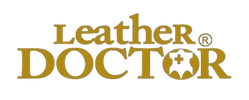![]() Leather pH Balanced Degreaser 2.2 by Leather Doctor® is a professional, pH-balanced (2.2) water-based degreaser that removes body oils, sweat, and grease from leather surfaces. Like shampooing hair, degreasing requires rinsing to carry away suspended soils—leaving leather clean without stripping its essential oils.
Leather pH Balanced Degreaser 2.2 by Leather Doctor® is a professional, pH-balanced (2.2) water-based degreaser that removes body oils, sweat, and grease from leather surfaces. Like shampooing hair, degreasing requires rinsing to carry away suspended soils—leaving leather clean without stripping its essential oils.
- Unlike solvent-based degreasers that dissolve the tannery-applied fatliquor (the essential blend of oils and fats), causing leather to become stiff, dry, and brittle, Degreaser 2.2 works with tannery science.
- Its low pH 2.2 controlled formula maintains the ionic attraction between leather fibers, tanning agents, dyes, and fatliquor.
- This ensures the leather remains supple, strong, and ready to accept hydration and replenishment, restoring its original softness and durability.
 Comparison: Water-Based Degreaser vs. Solvent-Based Degreaser
Comparison: Water-Based Degreaser vs. Solvent-Based Degreaser
| Feature | Leather Doctor® Degreaser 2.2 (Water-Based, pH 2.2) | Solvent-Based Degreasers |
|---|---|---|
| Leather Safety | Leather-safe, maintains ionic pH balance | Strips essential oils, destabilizes pH |
| Effect on Fatliquor | Preserves & prepares for replenishment | Dissolves & removes original fatliquor |
| Softness & Strength | Restores suppleness and tensile strength after hydration & fatliquoring | Leaves leather stiff, dry & weak |
| Compatibility | Safe for all leather types, including Nubuck & Suede | Risky on absorbent & delicate leathers |
| Tannery Alignment | Follows tannery science: clean → hydrate → fatliquor | Works against tannery principles |
![]() Key Benefits:
Key Benefits:
-
Water-based formula rinses clean like shampoo for leather
-
pH 2.2 controlled preserves ionic balance and prevents denaturing into rawhide
-
Removes sweat, grease, and oils without stripping natural fatliquor
-
Prepares leather for hydration and fatliquoring to restore suppleness
-
Ideal for headrests, armrests, collars, cuffs, handbag handles & steering wheels
-
Safe for all leathers, including Nubuck and Suede
![]() How It Works:
How It Works:
-
Shake until formula thickens into a gel.
-
Apply with brush or eraser, let dwell 3–30 minutes.
-
Wipe off suspended oils with terry towel.
-
Rinse with Rinse 3.0.
-
Optional acidifying conditioning with Acidifier 2.0 to a healthy squeaky feel.
-
Use Hydrator 3.3 & reverse-transfer with Towel 5 for deep cleaning.
-
Complete with Fatliquor 5.0 to restore softness & strength.
![]() By following these steps and using Degreaser 2.2 in combination with Leather Doctor’s leather-safe products, you can effectively restore and maintain the cleanliness, suppleness, and durability of your leather items.
By following these steps and using Degreaser 2.2 in combination with Leather Doctor’s leather-safe products, you can effectively restore and maintain the cleanliness, suppleness, and durability of your leather items.
![]() Frequently Asked Questions
Frequently Asked Questions
- What Makes Leather Prone to Absorbing Body Oil, Grease, and Sweat?
- Why is Leather-Safe Degreasing Important?
- How to Remove Dry Soiling before Degreaser 2.2?
- How to Control Leather Tackiness after Degreaser 2.2 + Rinse 3.0?
- How to Deep Clean Penetrated Soiling After Degreaser 2.2?
- How to Remove Soiling after the Degreasing Process with the Reverse-Transfer Technique?
- How to Restore Leather Suppleness after the Degreasing Process?
Updated: March 19, 2025 | July 20, 2025 | August 11, 2025 | September 1, 2025 | September 10, 20215 by Roger Koh
1 Review Hide Reviews Show Reviews
-
Degreaser 2.2 - true to its usage
this degreaser can really remove grease and oil. love it!!!








